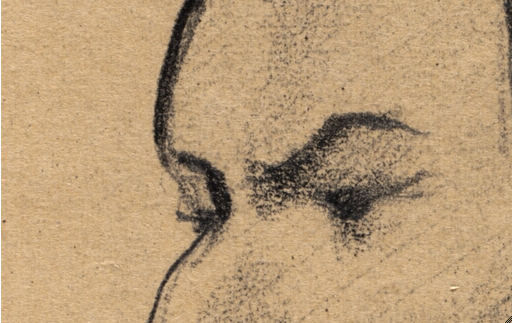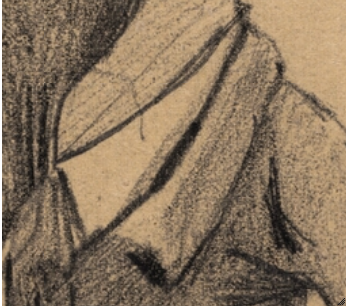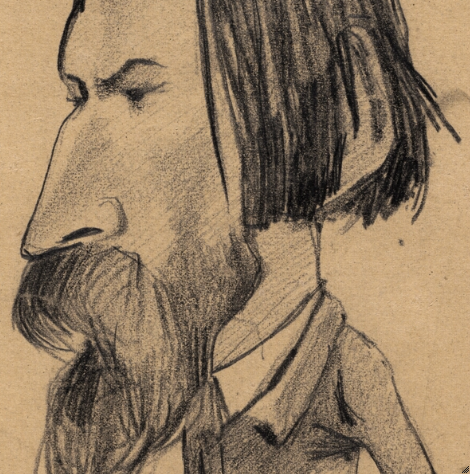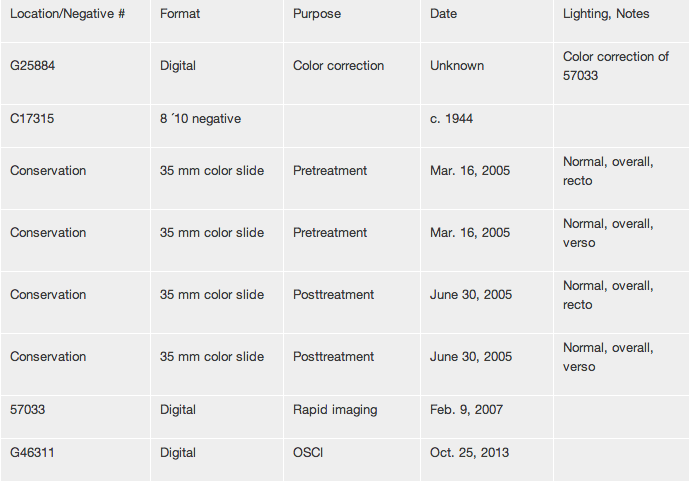Cat. 1
Caricature of Auguste Vacquerie
c. 1859
Graphite with erasure on tan wove paper; 284 × 176 mm
The Art Institute of Chicago, Mr. and Mrs. Carter H. Harrison Collection, 1933.897
Technical Report
Technical Summary
Claude Monet’s Auguste Vacquerie was drawn in graphite on tan wove paper. The artist used fine graphite lines to establish the general form and define facial details but then developed the figure further with dark, dense lines, particularly in the hair and eyes, and broad areas of shading to create volume (fig. 1.1). Some areas capture the slight surface texture of the wove paper, most noticeably in the face. Touches of erasure were used to create highlights along the nose and the coat collar (fig. 1.2).
Media and Support
Support Characteristics
Primary paper type
Cream, moderately thick, slightly textured wove paper.
Furnish
Even, appears short-fibered.
Formation
Slightly irregular formation overall, with pulp clumps.
Other characteristics
All edges of the sheet exhibit some degree of irregularity.
Dimensions
284 × 176 mm
Preparatory Layers
No artistic surface alterations or coatings are visible in normal conditions or under magnification. There is a pale-yellow visible-light fluorescence under UV illumination that is characteristic of a light gelatin surface sizing.
Media Characteristics
Graphite was used overall. The graphite appears quite soft, as it is dark in color, has high light reflectance in oblique illumination, and exhibits little surface deformation in the sheet. Dense graphite lines establish the general form and define facial details and hair. Light shading with the side of the graphite stick or pencil creates volume in the figure. Some broad areas of shading pick up the fine texture of the wove paper.
Touches of erasure sharpen highlights in the face, particularly along the nose and coat collar (fig. 1.3).
There is no drawing on the verso.
Compositional Development
No revisions or changes are visible in the composition in normal conditions or under magnification. Some lines have been reinforced with a second stroke in the same graphite.
Surface Treatment
No fixatives or coatings are visible in normal conditions, under UV illumination, or under magnification.
Condition History
The drawing was removed from a cream card mount, bordered with blue paper, as noted in the conservation report. All edges of the sheet are trimmed slightly irregularly. The paper appears to be discolored overall, although it is not possible to determine the original color. There is a slightly lighter band along the left edge that is approximately 10 mm wide.
A few scuff marks are visible overall, particularly at the upper right near the figure’s ear, at the lower center area, and across the center left side. There is light surface soiling and stray graphite medium around the perimeter of the sheet.
Thinned spots in the paper sheet appear overall; they are most visible along the left side on the verso when viewed in transmitted illumination. A few faint stains and small surface abrasions are visible.
Kimberly Nichols
Provenance
Alfred Dusseuil (1878–1927), Paris.
Sold by Henri Cottereau, Paris, to Carter H. Harrison (1860–1953), Chicago, winter 1927–28.
Given by Carter H. Harrison to the Art Institute of Chicago, 1933.
Exhibition History
New York, Wildenstein and Company, A Loan Exhibition of Paintings by Claude Monet for the Benefit of the Children of Giverny, Apr. 11–May 12, 1945, cat. 84.
Williamstown, Mass., Sterling and Francine Clark Art Institute, The Unknown Monet: Pastels and Drawings, June 24–Sept. 16, 2007, pp. 39–40, fig. 31; 300; Royal Academy, London, March 17–June 10, 2007.
Selected References
Hugh Edwards, “The Caricatures of Claude Monet,” Bulletin of the Art Institute of Chicago 37, 1 (Jan. 1943), p. 71.
Charles Merrill Mount, Monet, a Biography (Simon & Schuster, 1966), p. 396 (ill. after p. 191).
Raymond Cogniat, Monet and His World (Viking, 1966), pp. 9 (ill.); 131.
Pierre Georgel, “Monet, Bruyas, Vacquerie et le Panthéon Nadar,” Gazette des beaux-arts 72 (Dec. 1968), pp. 331–34, fig. 1.
Mitsuhiko Kuroe, Monet (Shueisha, 1970), p. 97 (ill.).
Daniel Wildenstein, Claude Monet (Fratelli Fabbri, 1971), p. 89, no. 29 (ill.).
Rodolphe Walter, “Claude Monet as a Caricaturist: A Clandestine Apprenticeship,” trans. Eric Young, Apollo 103 (June 1976), pp. 489–91.
Harold Joachim and Sandra Haller Olsen, French Drawings and Sketchbooks of the Nineteenth Century, vol. 2 (University of Chicago Press, 1979), pp. 69–70, no. 4A11.
Daniel Wildenstein, Claude Monet: Catalogue raisonné, vol. 5, Supplément aux peintures: Dessins; Pastels; Index (Wildenstein Institute, 1991), p. 148, cat. D505 (ill.).
Other Documentation
Examination Conditions and Technical Analysis
Raking Visible Light
Paper support characteristics identified.
Transmitted Visible Light
Paper mold characteristics identified.
Ultraviolet-Induced Visible Fluorescence (365 nm)
Light surface size detected overall.
Binocular Microscopy (80–100×)
Media identified.
Image Inventory
The image inventory compiles records of all known images of the artwork on file in the Imaging Department and in the conservation and curatorial files in the Department of Prints and Drawings at the Art Institute of Chicago (fig. 1.4).




